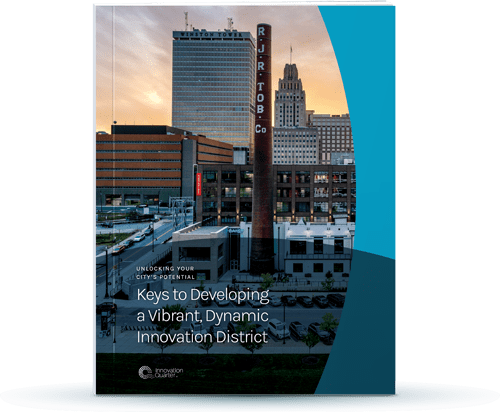Successful innovation districts become hatching grounds that allow intellect, leaders and communities to grow. Not only do they provide the physical space and an innovation ecosystem from which ideas can spring forward, but they are also catalysts for positive change in the immediate surrounding areas.
What is an Innovation Ecosystem?
It’s not enough to simply place organizations near each other and make them accessible to people. It takes relationships, support and interconnectedness among those organizations for an innovation district to flourish.
This fruitful collaboration and its resulting implications cultivate an innovation ecosystem—ideas, developments and partnerships that intangibly exist among and between start-ups, accelerators, entrepreneurs, local governments and institutions in close proximity and allow them to prosper as a whole. These ecosystems have the power to facilitate urban and downtown revitalization by contributing to economic growth, nurturing the next generation of the workforce and fostering inclusivity.
Start-up Support Drives Economic Growth
Start-ups need an innovation ecosystem to thrive. While they are agile, growth-focused companies, they need reliable resources and stable support from partners to be successful. Conversely, cities need successful start-ups to stay relevant in forward-looking spaces like healthy aging, virtual health and experiential learning.
The physical proximity that defines innovation districts provides these young companies with access to the funding, networks and talent necessary to take off and contribute to the local economy through job creation and keeping money in the community. Job growth is a significant indicator of a city’s success and is often analyzed by sector (innovation, services, retail/restaurants) to determine how much growth is innovation-based and how much is occurring as a result.
Academic Institutions Promote Cutting-edge Expertise
Academic (or anchor) institutions are vital to an innovation ecosystem’s most significant benefit: fresh, forward-thinking perspectives. The relationships between anchor institutions and other players in the ecosystem are critical for a city that wants to stay at the forefront of development. Not only do these institutions help fund many research initiatives, but they become part of a pathway for fresh talent and young entrepreneurs to enter the local workforce.
By getting students involved in the ecosystem early, they are more likely to stick around after graduating, develop influential connections and continue to contribute their cutting-edge expertise. The number of people trained within an innovation district’s industries is another indicator for urban success, as these trainees ultimately become experts and leaders in their industries.
Collaborative Environments Foster Inclusivity
Innovation ecosystems do not exist without collaboration. Whether it’s co-hosting events, cross-promoting or sharing resources, how diverse, neighboring organizations work together to create an innovative ecosystem is what separates innovation districts from business parks, financial hubs and traditional research parks.
Breaking down entry barriers by converging a wider range of organizations and entrepreneurs allows the ecosystem to give back to more of the community. When done correctly, the inclusive byproduct of innovative ecosystems can help lessen economic disparity through access to partners, resources, ideas and affordable housing. Rather than operating independently or interacting within the same limiting, homogenous sector, minority entrepreneurs can gain access to major partners they otherwise would never have had contact with by finding their space in an innovation district.
When Innovation Ecosystems are a Springboard for Growth
Downtown Revitalization in the Innovation Quarter
The success of Winston-Salem’s Innovation Quarter is evident through its people and partnerships—and the numbers don’t lie either. Its robust and inclusive innovation ecosystem has seen measurable growth across its workforce, education and community.








Winston-Salem’s workforce is growing at a faster rate than most of North Carolina.[1] Between the 170 companies and five academic institutions it houses, the Innovation Quarter workforce alone includes more than 3,700 people and has more than 8,000 trainee participants and 1,800 degree-seeking students.
Over $1.5 billion has gone into revitalizing downtown Winston-Salem, including development outside of the Innovation Quarter’s formal confines, since 2000. The city invested $28 million into replacing its Central Library with a 106,000 square foot space that houses 90 public computers, extending internet access throughout the community. UNC School of the Arts’ board of trustees has plans to spend $32.5 million on renovations to the Stevens Center for music, dance and theater.[2]
The Innovation Quarter community is committed to sharing resources, hosting events and extending an open hand to people of all backgrounds and identities. Diverse programming and partners that are founded by or provide resources to women and people of color are not uncommon in the Innovation Quarter:
- Soy Emprendedor, a program instilling an entrepreneur mindset in Black and Latinx students, uses the Innovation Quarter space for an accelerator program that pairs students with a mentor to brainstorm, develop and present a concept to local entrepreneurs.
- The Innovation Quarter partners with the Second Harvest Foodbank of Northwest NC to host a weekly drive-through produce pantry.
- HUSTLE Winston-Salem leverages creative strategies and community partnerships to accelerate underrepresented entrepreneurs. HUSTLE W-S has made the Innovation Quarter’s Center for Design and Innovation its home.
Innovation Ecosystems are Worth Working For
There’s no getting around the fact that developing an innovation district and ecosystem requires meticulous planning, substantial financial investments and an ongoing devotion to community to be successful. However, innovation districts also play a key role in transforming urban and downtown districts—proving that investing in a more equitable place is worthwhile.




